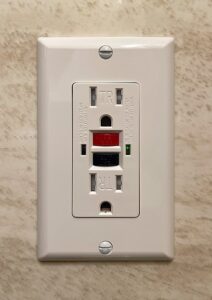
Choosing the right Ceiling Fan for your space
A ceiling fan is a great way to keep your home cool and comfortable during the hot Summer months but it’s also a valuable tool to circulate warm air in the Winter and bring in fresh air in the Spring and Fall. In addition to being the easiest and quickest way to change the temperature of a room. a ceiling fan is also a stylish way to add light to a space. But, when it comes to choosing a ceiling fan, there are a lot of variables to consider. What size fan do you need? What style would best fit your room? And what features are worth the extra investment? With so many options on the market, it can seem to be a daunting decision. In this buyer’s guide, we’ll give you some tips on how to navigate the maze of options and choose a ceiling fan that will be perfect for your specific space and needs.
Ceiling Fan Form and Function
Ceiling fans are where form can truly meet function. But in order to get the most out of your purchase, it’s important to understand how ceiling fans operate. Ceiling fans work by rotating blades that move air around the room. The fan appears to be mounted on the ceiling but the fan is actually mounted to an electrical box that is affixed to the ceiling joists. The blades rotate around a central shaft that is powered by an electric motor. The motor controls the rotational speed of revolutions per minute and the direction of circulation determines whether it will cool a room or circulate warm air.
Lets Talk Ceiling Fan Motors
The three main types of motors are direct drive, belt drive, and brushless DC. Direct drive motors are the most common type; they’re simple and efficient but can be noisy. Belt drive motors are quieter than direct drive motors but tend to be more expensive. Brushless DC motors are newer on the market and offer energy efficiency and low noise levels but can also be more expensive than other options. Most ceiling fans will rotate approximately 200 to 350 times per minute (RPM). Finally, you have the choice of an AC or DC motor. DC motors are not only smaller than AC ones, but they also offer better overall reliability and longer lifespan. They can be designed to work with a variety of ceiling fan designs because designers use more creative components in order for them to get cool enough airflow without causing any noise or generating too much heat from the electric current running through them.

How Blades Effect Ceiling Fan Circulation
The efficiency of circulation comes down to VFD (Volume, Force & Direction) and this is all primarily controlled by the blades. The blades length, angle and speed determine the amount and force of the air circulation. Longer blades move larger volumes of air. The speed of the blades controls the strength and distance of the breeze and the ceiling fan blade direction helps with temperature regulation. Lastly, the angle of the blades affects how the air is captured and lifted.
Now You’re Ready To Choose Your Ceiling Fan
Once you understand the operation of the ceiling fan the next step is to choose a ceiling fan for your space and uses. Firstly, consider where your fan will be installed. If your fan is to be installed outside be sure to choose an exterior fan rated to withstand moisture. Also, you want to choose the right size fan for your room or area to get the desired airflow. Second, consider how your fan will be used. If you are looking for cooling, the length, angle, and a number of blades are important. If your goal is to distribute warm air more efficiently you will want a ceiling fan with reversible blades and variable speeds. The height of the installation is also a factor to consider. A good rule of thumb is the larger the space the larger the fan. The higher up you go, the more blades you will need.
Choosing The Right Ceiling Fan Blades
One of the most important considerations when choosing a ceiling fan is the size of the blades. Blades that are too small for a space may not move enough air, and blades that are too large can move too much, making the room uncomfortable. The ceiling fan blades should be at least 10 inches longer than the narrowest point of the room. If your room is less than 50 square feet, you’ll want a fan with 29-inch blades. For rooms between 50 and 100 square feet, opt for a fan with 36-inch blades. Larger rooms (100-250 square feet) will need a 42-inch fan, and very large rooms (250 square feet or more) will need a 52-inch blade ceiling fan.
Ceiling Fan Operation
Many fans have remote controls, but not all do. Determine whether a remote is necessary and if your fan does have a reversible blade feature, pay attention to whether this is changed with the remote or a physical switch on the base (which can get cumbersome in homes with higher ceilings). Additionally, most fans can be automated and tied into a smart home system and controlled by your phone, voice or automated.

Ceiling Fan Moisture Ratings
Outdoor ceiling fans come with two moisture ratings, Wet and Damp. While wet-rated ceiling fans can be installed in almost any outdoor setting, damp-rated fans are for outdoor areas where there is moisture present but no direct contact with water is expected, such as a covered porch or gazebo.
Ceiling Fan Lighting
While not all fans are equipped with light kits those ceiling fans that do can do double duty as the main lighting source for a room. Although it may come with a light kit, the fan may come with a cover that allows you to omit the lighting altogether or customize it with your own choice. If you do choose to use your fan as lighting, take note of whether it provides a warm light or white light or some combination of both. Some fans have bulbs that can be changed to your preference. The lighting in a room can change the entire feel of a space, so make sure that you are getting the shades that you prefer before purchasing.
Ceiling Fan Esthetics
When shopping for a ceiling fan, you’ll find a wide variety of designs to choose from, ranging from traditional to contemporary. And with so many different finishes available, including wood, brushed metal, acrylic, and even crystal, it’s easy to find a ceiling fan that complements your existing furniture and fixtures. Take into account the size of your space. A fan that is too big or too small can change the appearance of space in an area for the negative. In large spaces, it may be better to install two appropriate-sized fans vs one large one. Down rods should also be considered if the room has high ceilings.
Ceiling Fan Styles
Like other electrical fixtures, there is a wide variety of ceiling fan styles to choose from. Whether you’re looking for a sleek and modern design or a more traditional option, there’s sure to be a ceiling fan that’s perfect for your home. One popular style is the hugger ceiling fan, which is designed to be mounted close to the ceiling. This type of fan is ideal for rooms with low ceilings, and it can help to save space. Another popular option is the chandelier ceiling fan, which combines the look of a traditional chandelier with the functionality of a ceiling fan. This type of fan is perfect for adding a touch of elegance to any room. There are propeller fans for small stairway foyers, bladeless fans for a clean look, retractable fans for an “invisible” appearance and ornate flat blade fans that make a statement. The style options are endless and with some searching, you really can find one that gives your home a look that is unique to you.

Ceiling Fan Purchase Resources
Of course, the big box home improvement stores have fans on the floor for immediate purchase but you can access more options for delivery online. You can also find some other affordable options on Amazon.com or Wayfair.com. If you are looking for a more unique fixture you can search lighting outlets such as shadesoflight.com or palmfanstore.com. Dans Fan City or Burgess Lighting are a couple of local providers with brick-and-mortar showrooms.
Ceiling Fan Assembly
Every ceiling fan has its own unique set of assembly instructions that must be followed. Each wire-nut and screw washer should be affixed as directed for your safety and the longevity of a fan. A slightly loose screw will unscrew itself over time and even a slightly loose blade can cause a severe wobble, so proper assembly is crucial.
Ceiling Fan Installations
The complication of installation depends on whether you are replacing an existing fixture or installing a fan where no electrical fixture currently exists. For a fan replacement, the electrical wiring should already be in place. But, when changing from a lighting fixture to a fan, a fan-rated box needs to be installed to ensure the fan will stay in place. For a new ceiling fan install power needs to be run from the closest existing source to the new fixture and likely a new switch will need to be installed for control.
How Much Does It Cost To Install A Ceiling Fan?
Given that all existing wiring and boxes are in appropriate condition, you can expect to pay between $250-$500 depending on whether it is a new install or replacement, the intricacy of assembly, the weight of the fixture, and the height it is to be hung.
For new ceiling fan installations, the key factors that affect installation price are the distance from existing power, if there will be a switch connected, and obstructions to the wire run. Depending on the specific conditions of your installation some drywall cutting and patching may be necessary.
Why Use HPM To Install Your Ceiling Fan?
Here at Hawkins Property Management, we pride ourselves on doing every job flawlessly and when it comes to ceiling fan installations, nobody does it better (or more affordably) than us. Our Master Electrician has years of experience and will make sure that your fan is professionally installed and looks great. You don’t have to worry about climbing a ladder, crawling through your attic or dealing with electricity – we’ll take care of everything for you. So why wait? Call us today and see for yourself how easy and affordable it is to have a professionally installed ceiling fan anywhere inside or outside of your home. You’ll be glad you did!
Protect Your Investment Property with the Right Insurance
If you are a landlord leasing your property, you must protect your investment from any
Forming A Virtual Neighborhood Watch
How to Create A Virtual Neighborhood Watch Since the pandemic, everything has gone virtual. With

What You Need To Know About Safety Outlets
Safety Outlet Guide. Learn everything you ever wanted to know about GFCI’s and and AFCI’s and why you need them in your home.

Hawkins Property Management llc (dba HPM Electrical Services) is a licensed and insured Maryland Home Improvement Contractor specializing in Property Management and Electrical Repairs and Installations.
Hawkins Property Management LLC
DBA HPM Electrical Services
[email protected]
301-202-4352 Voice
301-246-8421 Text
Request An Estimate
See Our Prices
Proof Of Insurance
MD MHIC #102378
MD Master Electrician #14559
VA Master Electrician #2710064479
MD Real Estate License #653277
